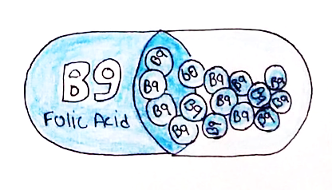A pregnancy is dated by the weeks of gestation from the first day of the mother’s last menstrual period (LMP)
– Embryonic age = Gestational age – 2 weeks (as fertilization occurs about 2 weeks after the LMP)
In order to record how many times a woman has been pregnant, the gravida/parity/abortus system is used:
Gravida = the number of times a woman has been pregnant, regardless of the pregnancy outcome
Parity = The number of pregnancies which have survived > 20 weeks (including live births and stillbirths)
Abortus = the number of pregnancies that were lost at a gestational age of 20 weeks or less
For example, a woman who is G3P2A1 means that she has been pregnant a total of 3 times:
– In 2 of these times, it means that the fetus was carried >20 weeks
– In one of these times however, she had a miscarriage (loss of pregnancy before 20th week)
Therefore Gravida = Parity + Abortus
The normal duration of pregnancy is 40 weeks (280 days)
–> Preterm birth –> live birth before the completion of 37 weeks (< 37 0/7) of pregnancy
–> Post-term birth –> live birth after 42 weeks (> 42 0/7) of pregnancy
Trimesters
Important Factors in Pregnancy
There are a number of important factors to consider for a mother during pregancy:
i) Alcohol:
– It is important to avoid alcohol throughout the whole pregnancy, especially binge drinking
– This is because it can lead to foetal alcohol syndrome (FAS) which impacts early brain development
ii) Smoking:
– This gives increased risk of miscarriage, IUGR (low birth weight) and pre-term labour
– Nicotine replacement therapy can be used during pregnancy, but varenicline/bupropion are contraindicated
iii) Exercise:
– Moderate exercise is not associated with adverse outcomes
– But women should avoid scuba-diving and high impact sports with high risk of abdominal trauma
iv) Sexual Intercourse:
– This is not associated with adverse outcomes
v) Travel:
– Air travel is associated with increased risk of venous thromboembolism due to the immobility
– Therefore, it is advised that women >37 weeks should avoid air travel
– If the woman has had multiple pregnancies, then it is suggested that she should avoid air travel > 32 weeks
– If on the plane, she should wear compression stockings to reduce the risk of DVT
vi) Nutrition:
– Carrying the fetus places an additional demand on the nutritional status of the women, and so they must take additional supplements of certain minerals whilst avoiding others.
Supplements:
Folic Acid (B9):
– This is taken in order to reduce the risk of neural tube defects
– Normal Dose –> 0.4mg daily from 4 weeks before conception to 12 weeks’ gestation
– If at high risk (history of NTD, obese, on antiepileptics or coeliac/diabetes/thalassemia), then take a higher dose –> 5mg daily instead of 0.4mg

– Vitamin D –> 10 micrograms to be taken daily
– Iron 30-60mg –> This is taken to if Hb<110g/dl to prevent anaemia
– Vitamin B12 –> Recommended for vegan mothers
Foods to avoid in pregnancy
Termination of Pregnancy (TOP)
The rules regarding termination of pregnancy are based on the 1967 Abortion Act which was amended in 1990.
It states that abortion can be legally providing under the following conditions:
- The pregnancy has not exceeded 24 weeks.
- Continuation would involve risk of injury to the physical or mental health of the pregnant women or existing children in her family that is greater than if the pregnancy was terminated
- The termination is necessary to prevent injury to the physical or mental health of the pregnant woman
- The continuation of the pregnancy would involve risk to the life of the pregnant woman greater than if the pregnancy was terminated
- There is substantial risk that, if the child were born, it would suffer from such physical or mental abnormalities as to be seriously handicapped
In order to conduct an abortion:
i) Two registered medical practitioners must sign a legal document (in an emergency only 1 is needed)
ii) Only a registered medical practitioner can perform an abortion in an NHS hospital or licensed premise
There are different methods are used for abortion:
Medical methods:
Early medical abortions account for the majority of abortions before 9 weeks gestational age:
i) Methotrexate + Prostaglandin 48hr later (stimulate uterine contractions)
– This is used up to 7 weeks gestation
ii) Mifepristone (Progesterone antagonist) + Prostaglandin 48hr later (stimulate uterine contractions)
– This is used up to 10 weeks of gestational age
– This regimen works faster and is more effective at later gestational ages than the methotrexate regimen
Surgical methods:
i) Vacuum aspiration:
– This can be used up to 15 weeks gestational age
– It can be Manual vacuum aspiration (MVA) which consists of removing the fetus or embryo, placenta, and membranes by suction using a manual syringe
– Or can be Electric Vacuum aspiration (EVA) which uses an electric pump instead
ii) Dilation and evacuation:
– This is used after 12-16 weeks
– It consists of opening the cervix and emptying the uterus using surgical instruments and suction
– This is performed through the vagina and does not use an incision
iii) Intact dilation and extraction:
– This is a surgical procedure that involves removing a fetus from the uterus
– It is used for abortions in the second and third trimesters of pregnancy
– It is a fairly rare method of abortion which is not used routinely
iv) Hysterotomy abortion:
– This is a surgical procedure that removes the fetus from the uterus
– The process and method are very similar to a caesarean section
– It is not routinely used and instead reserved for cases where other methods are not appropriate e.g., in placenta accreta.
Other methods:
Labour induction abortion:
– This is a procedure which is performed from 13 weeks to the 3rd trimester.
– The process involves first inducing labour and then inducing foetal demise

